 | ||
Antibiotics for Anaerobic Infections (Antibiotics - Lecture 6)
An anaerobic organism or anaerobe is any organism that does not require oxygen for growth. It may react negatively or even die if oxygen is present. (In contrast, an aerobic organism (aerobe) is an organism that can survive and grow in an oxygenated environment.)
Contents
- Antibiotics for Anaerobic Infections Antibiotics Lecture 6
- First observation
- Classification
- Energy metabolism
- Fermentation
- Culturing anaerobes
- Multicellularity
- References
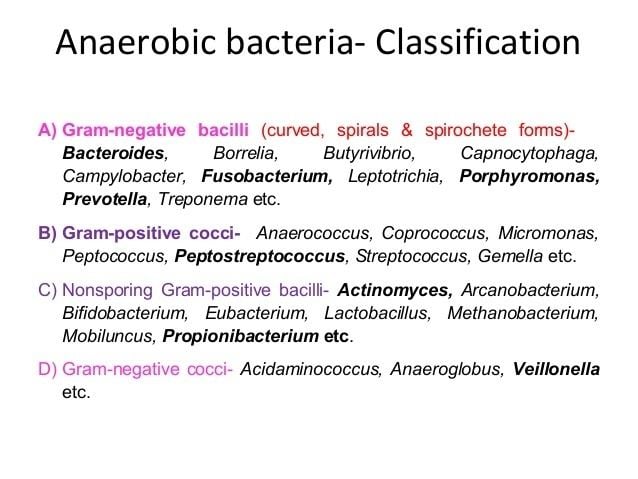
An anaerobic organism may be unicellular (e.g. protozoans, bacteria) or multicellular. For practical purposes, there are three categories of anaerobe: Obligate anaerobes, which are harmed by the presence of oxygen; aerotolerant organisms, which cannot use oxygen for growth but tolerate its presence; and Facultative anaerobes, which can grow without oxygen but use oxygen if it is present.
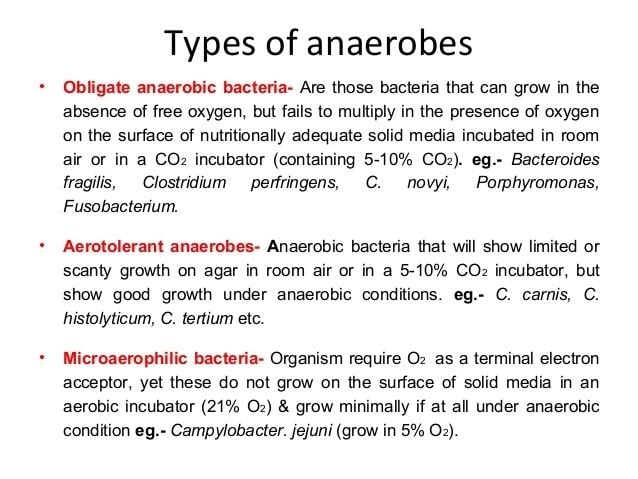
First observation
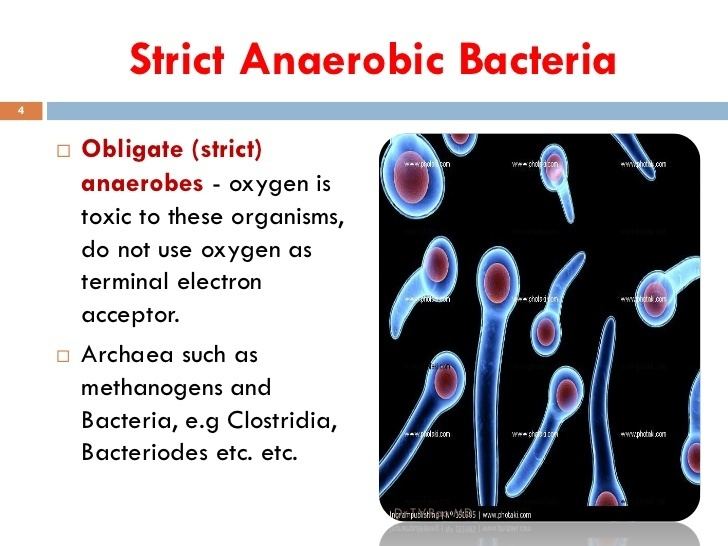
In his letter of 14 June 1680 to The Royal Society, Antonie van Leeuwenhoek described an experiment he carried out by filling two identical glass tubes about halfway with crushed pepper powder, to which some clean rain water was added. Van Leeuwenhoek sealed one of the glass tubes by using a flame and left the other glass tube open. Several days later, he discovered in the open glass tube ‘a great many very little animalcules, of divers sort having its own particular motion.’ Not expecting to see any life in the sealed glass tube, Van Leeuwenhoek saw to his surprise ‘a kind of living animalcules that were round and bigger than the biggest sort that I have said were in the other water.’ The conditions in the sealed tube had become quite anaerobic owing to consumption of oxygen by aerobic microorganisms.

In 1913 Martinus Beijerinck repeated Van Leeuwenhoek's experiment and identified Clostridium butyricum as a prominent anaerobic bacterium in the sealed pepper infusion tube liquid. Beijerinck commented:
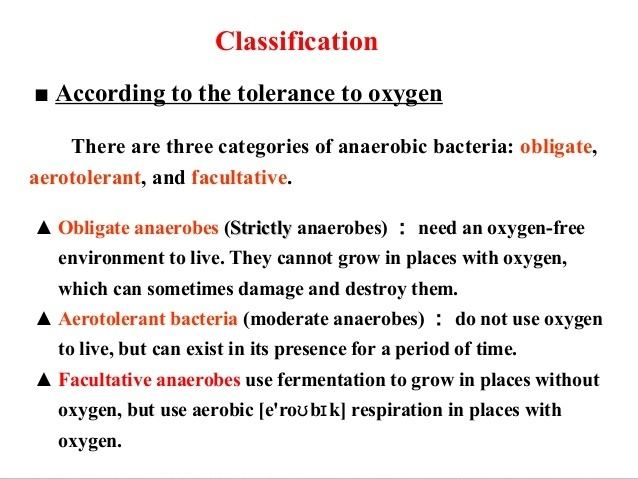
'We thus come to the remarkable conclusion that, beyond doubt, Van Leeuwenhoek in his experiment with the fully closed tube had cultivated and seen genuine anaerobic bacteria, which would happen again only after 200 years, namely about 1862 by Pasteur. That Leeuwenhoek, one hundred years before the discovery of oxygen and the composition of air, was not aware of the meaning of his observations is understandable. But the fact that in the closed tube he observed an increased gas pressure caused by fermentative bacteria and in addition saw the bacteria, prove in any case that he not only was a good observer, but also was able to design an experiment from which a conclusion could be drawn.'
Classification
For practical purposes, there are three categories of anaerobe:

Energy metabolism

Some Obligate anaerobes use fermentation, while others use anaerobic respiration. Aerotolerant organisms are strictly fermentative. In the presence of oxygen, facultative anaerobes use aerobic respiration; without oxygen, some of them ferment; some use anaerobic respiration.
Fermentation
There are many anaerobic fermentative reactions.
Fermentative anaerobic organisms mostly use the lactic acid fermentation pathway:
C6H12O6 + 2 ADP + 2 phosphate → 2 lactic acid + 2 ATP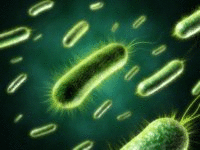
The energy released in this equation is approximately 150 kJ per mol, which is conserved in regenerating two ATP from ADP per glucose. This is only 5% of the energy per sugar molecule that the typical aerobic reaction generates.
Plants and fungi (e.g., yeasts) in general use alcohol (ethanol) fermentation when oxygen becomes limiting:
C6H12O6 (glucose) + 2 ADP + 2 phosphate → 2 C2H5OH + 2 CO2↑ + 2 ATP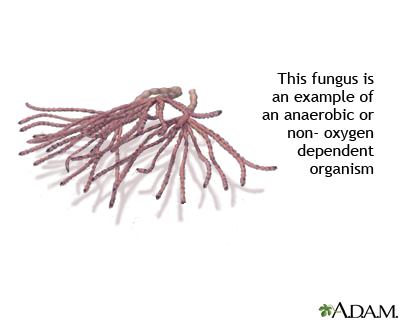
The energy released is about 180 kJ per mol, which is conserved in regenerating two ATP from ADP per glucose.
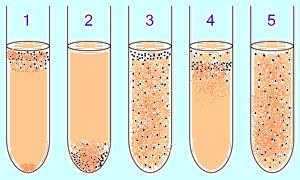
Anaerobic bacteria and archaea use these and many other fermentative pathways, e.g., propionic acid fermentation, butyric acid fermentation, solvent fermentation, mixed acid fermentation, butanediol fermentation, Stickland fermentation, acetogenesis, or methanogenesis.
Culturing anaerobes

Since normal microbial culturing occurs in atmospheric air, which is an aerobic environment, the culturing of anaerobes poses a problem. Therefore, a number of techniques are employed by microbiologists when culturing anaerobic organisms, for example, handling the bacteria in a glovebox filled with nitrogen or the use of other specially sealed containers, or techniques such as injection of the bacteria into a dicot plant, which is an environment with limited oxygen. The GasPak System is an isolated container that achieves an anaerobic environment by the reaction of water with sodium borohydride and sodium bicarbonate tablets to produce Hydrogen gas and carbon dioxide. hydrogen then reacts with oxygen gas on a palladium catalyst to produce more water, thereby removing oxygen gas. The issue with the Gaspak method is that an adverse reaction can take place where the bacteria may die, which is why a thioglycollate medium should be used. The thioglycollate supplies a medium mimicking that of a dicot, thus providing not only an anaerobic environment but all the nutrients needed for the bacteria to thrive.
Multicellularity
Complex multicellular life that does not need oxygen is said to be rare, however there are examples of such organisms.
At least three species have been discovered in the hypersaline anoxic L'Atalante basin at the bottom of the Mediterranean Sea in 2010, metabolizing with hydrogen, lacking mitochondria and instead using hydrogenosomes.
Some organisms metabolise primarily using glycogen, for example the Nereid (worm)s and some polychaetes, or the juvenile Trichinella spiralis (pork worm) parasites.)
